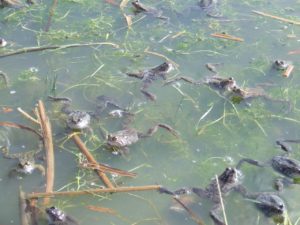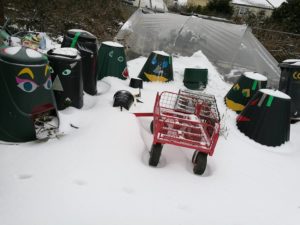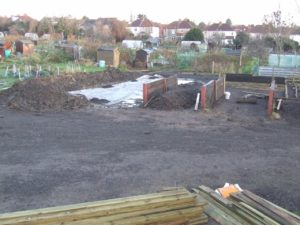Wildlife and Sustainability

In this section you will find out about the varied wildlife that can be seen on the allotments. These include many different species of birds, mammals, insects and pond-loving creatures. Also the importance of sustainability in how we grow our produce is discussed.
Wildlife
Allotment sites with their mosaic of habitats and wildlife corridors have become valuable sanctuaries for wildlife and an important connection with nature for its urban plot holders. Research has shown that allotments can support nearly a third more species than parkland.1 Plotholders’ daily lives are enriched through their contact with wildlife and each season brings its own unique flavour of wildlife whether it’s meetings with familiar friends or the treat of seeing a more unusual visitor.
Birds
Birds are typically the most obvious of visitors with an estimated tally of 25 or more different species have visited the site. Plotholders describe how magical it is to sit in the shed watching the flight of blackbirds, starlings, crows and pigeons, whilst songbirds such as blue tits, wrens and sparrows flit from hedge to blackthorn, and the squirrels and magpies exchange insults.
Many plotholders put up birdboxes on their plots to encourage birds to nest.
More unusual recent sightings include a large wading bird with a curved beak, possibly a curlew, on the wildlife pond; a squawking trio of parakeets flying overhead towards Donkey Lane and a rare urban sighting of a woodcock on Davies Field.
The ubiquitous robin is often seen feasting on any grubs that get unearthed. In comparison, only a lucky few have witnessed the dramatic aerial acrobatics of a sparrowhawk plucking their unlucky prey out of the sky. Hunting peregrine falcons have also been sighted overhead and other unmistakable presences on the skyline have been the grey heron and buzzard.
Green woodpeckers, with their loud, laughing call, are the largest of Britain’s three native woodpeckers, and are known to have nested near to Golden Hill. Equally noisy are the over-wintering redwings and fieldfares, where loose flocks tend to congregate in the fruit trees on Davies Field. In the winter can also be see a charm of Goldfinches grazing on old seed heads, twittering and flitting from one patch to the next.
Historical sightings include two rare white sparrows seen on Horfield allotments in 1937 which were being regularly fed by ‘an interested observer’!
Hedgehogs are a reassuring sight for the lucky few on Golden Hill,

with several seen, on Davies Field in particular. Nationally, hedgehog populations have been decimated due to a combination of factors including hedgerow loss and road deaths, with a 97% decline since the 1950s.Urban areas could offer a glimmer of hope with the decline levelling off when compared to rural populations.3 One of the nation’s favourite animals, this formidable hunter of slugs and larvae is welcomed by everyone.
Badgers are known to live in several places in Bristol suburbs, and there is a badger sett on Birchall Road allotments on the boundary with the Cairns Road houses. Although many regard badgers as a welcome sight, they can be a pest for vegetable growers and crops often need to be protected from their voracious appetite.
Fox populations have recovered since the ravages of mange in the 1980s with regular sightings of adults boldly going about their business during daylight hours or slinking around as twilight descends.
As the light fades in the evening, sharp-eyed plot holders can see fleeting glimpses of pipistrelle bats darting around the allotments. The smallest and commonest of British bats, pipistrelle’s also forage up and down the hedgerows on Donkey Lane hoovering up to 3,000 insects a night during the warm summer months.
Back in 1919 in the early days of the allotment site, a hare was chased across the allotments at the top end of Bishop Road. There have been no such sightings in recent years!
Hedgerows both within and around the Golden Hill allotments date back around 500 years or more, with these ancient relics featuring on the 1843 Tithe Map. These are being maintained by workparty volunteers. These wildlife corridors provide vital foraging corridors for insects, birds and mammals.
The bottom of the Golden Hill site is poorly drained soil and early maps show an old pond close to where the Monks Road car park is today. Older plot holders have memories of catching newts and tadpoles in this pond back in the 1940s The modern day wildlife pond was dug in 2003 and later remodelled as part of the Community Garden project in 2011. In spring the pond is alive with frogs and sticklebacks. Pond-dipping is still encouraged today at the wildlife pond with the polite proviso of “Catch, Admire, Put it Back”!

Frogs, toads and newts have been found across the allotment site, providing a vital public service snaffling up slugs and other beasties. Stealthy Toads have nearly been mistaken for stones whilst a fifty-strong gang of froglets was unearthed by one surprised allotmenteer.

Slow-worms often hide out within compost heaps, soil crevices and under sheets of plastic and are sometimes when turning over compost heap or soil, being snake-like in appearance and coloured metallic brown to a coppery-bronze.
Although allotments were initially meant for the production of vegetables and fruit, now nearly every plot has flowers growing on it in some shape or form. These blooms provide valuable nectar sources for butterflies, bees and other pollinating insects. The butterflies seen on the allotments include the bright yellow Brimstone, Peacocks, Red Admirals and Small Tortoiseshells, all of whom favour nettles as one of their choice for egg-laying sites. Other commonly seen butterflies are the Holly Blue and Common Blues, Gatekeeper, and Speckled Wood butterfly which loves feeding on aphid honeydew on leaves in the summer.
Insects beneficial to plotholders are encouraged by companion planting where flowers are used to repel unwanted pests: poached egg plants and marigolds are examples which they draw in hoverflies and bees.


The association’s bee keeping policy limits bee hives to three per field. However, in the peak of summer, the site is abuzz with honey bees. Some allotments have “bee hotels” fixed to the sheds providing potential nesting sites for solitary bees such as the mason and leaf-cutter bee.
Sustainability
Sustainability is defined as “the avoidance of the depletion of natural resources in order to maintain an ecological balance”. It’s about us being stewards of the natural resources so they remain healthy for future generations to enjoy.
Little detail is known about the methods of production used on the allotments over the last century, particularly regarding wildlife-friendly and organic growing. There have never been any specific rules governing how to grow on an allotment. E.g. whether or not to use non-organic chemicals, pesticides or fertilisers. However, there is a sense that, amongst plot holders today, many do garden organically, as there has been a national shift amongst the growing community to use fewer chemicals which are harmful to the environment and to work with the natural cycles when growing food.
One example of this is the Horfield Organic Community Orchard which was established in 1998 specifically to encourage the use of organic techniques in fruit growing thank to a team of dedicated enthusiasts who brought six abandoned plots on the Golden Hill site back to life.
Some other elements of sustainable growing are described below:
Green manures
Green manures such as crimson red clover and phacelia are soil enriching and also suppress weeds thus reducing the need to spray chemicals on weeds. They also provide protective cover for insects and valuable nectar for bumblebees and honey bees when left to flower.
Compost Heaps
Compost heaps are now ubiquitous on plots, usually plastic Dalek-like composters or home-made compost heaps fenced in by old pallets. However, this compost heaps weren’t always so common. In 1944, judges in the Best Plot Competition congratulated the association on the general standard of cultivation but ‘were sorry to notice that the compost heap, or pit, was conspicuous by its absence on the majority of plots’.

Plotholders were advised to improve plot cultivation and to address the general need for a far greater use of fertilisers with ‘so many plots in a starved condition’. The general tone of the advice appears to be one of using organic matter to improve soil fertility. Older plot holders recall soot being widely used for top dressing.
Compost
In 2003, a grant enabled the construction of large storage bins made from railway sleepers next to the car park at Golden Hill. Every year a truckload of compost is bought by the Association and deposited there for plotholders to buy and use on their plots.

Manure
Many plot holders add sizeable quantities of manure to their soil in the lead-up to another growing season, some layering it on the surface for the worms to incorporate, others digging it in. Trucks-loads of manure trundling their way up and down Donkey Lane, are a common sight from autumn through to spring, with some plot holders having dedicated storage areas located next to hauling ways.
Green fertilisers/mulches
Supplements of pungent comfrey teas are also added to the soil by some to nourish growing crops.
Mulching around crops helps with weed control, water conservation and the creation of better soil conditions. Mulching material is available by the barrow load as a by-product of the Parks department’s tree pollarding, with the allotment supply being frequently replenished.
Many plot beds are covered up over winter with black plastic sheets/membrane to keep the weeds at bay and warm the soil for earlier spring sewing.
Polytunnels
Polytunnels extend the growing season and allow a wider range of crops to be grown by a plot holder but can be rather thirsty! Several structures always succumb to the elements every year due to the strong winds which can blow untamed across the allotment.
Pest protection
Allotmenteers are usually pretty resourceful. Never ending battles with the local wood pigeons, cabbage whites and dastardly flea beetles manifests itself in a spectrum of bespoke fruit cages, netted beds, mesh tunnels and fleece cloches. Employing everything from arches of plastic piping through to foraged hazel sticks for support, bamboo canes topped with plastic pots/bottles create a bird-scaring rattle on windy days!
Companion planting
By planting specific flowers next to crops, it is possible to encourage insects, such as ladybirds and hoverflies, which then feed on the pests, such as aphids, that attack our crops, thus reducing the need to apply artificial pesticides.
Crop rotation
Shortly after WWII ended, the Association set-up a demonstration plot in Longs Field which was to be ‘cultivated on methodical lines paying particular attention to rotational cropping’ to assist members with better ‘planning of the ground in advance of the growing season’! This process helps prevent the build-up of pests and diseases, whilst also not depleting the soil of specific soil nutrients. A standard crop rotation cycle is 4 years but one of current Golden Hill plot holders even practices a nine bed rotation system!
Dig/No dig techniques
Today soil health is maintained by plot holders in number of different ways through techniques which affect the structure, richness and diversity of life within the soil. In the past double digging for deep soil cultivation was more common place, where a trench was dug to a spade’s depth, manure added, then a second trench was dug putting the soil into the previous trench, and so on.
This method contrasts sharply with the no dig plot which some plot holders practice nowadays, which minimises disturbance to the soil, is often used in combination raised beds. Often self-built these raised beds of varying sizes and arrangements bring further character to what are already hugely individualistic plots.
Water
On the Golden Hill site, a solar-powered pump (The Tower of Power) pumps well water uphill from a water table at the bottom of the site to the top where large water tanks store it; gravity is used to feed the water troughs dotted around the site. As well as reusing water, this saves the Association a considerable amount of money on water charges. Many individual plotholders also use water butts to capture water from shed roofs.

There is also an accessible composting toilet on the Golden Hill site and a rather more rustic version on the community orchard site. These also help to save water.
Electricity
Power-wise the allotment sites are effectively off-grid but the Golden Hill Balehouse uses the solar panels to feed a battery which gives light and power.
References
1. The Bristol Biodiversity Action Plan 2008
https://www.bristol.gov.uk/documents/20182/35052/BBAP.pdf/9074afdf-8f21-4296-b457-bc50830f0efc
2. Horfield and District Allotments Association – Our Wildlife going Wild on the Allotments by Joe McSorley, April 2012
4. The Guardian, Wednesday 7 February 2018; Hedgehog numbers plummet by half in UK countryside since 2000
https://www.theguardian.com/environment/2018/feb/07/hedgehog-numbers-plummet-by-half-in-uk-countryside-since-2000
5. Butterfly Conservation blog 29 July 2016 – look out for the Speckled Wood butterfly
https://butterfly-conservation.org/48-12838/look-out-for-the-speckled-wood-butterfly.html



